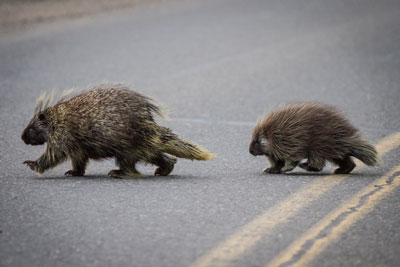




Porcupines, "porkies," or "quill pigs" cannot throw their quills at you or your pets. You must actually touch the quill even very slightly for it to stick in you. If you leave porcupines alone, they will continue on their way and leave you alone. However, most of our pets have not learned that lesson and they can be seriously or very painfully injured from encounters with porcupines. Cattle and horses have also been known to nuzzle a "porkie" and get "quilled." Quills left in pets or livestock may cause fatal injury if not removed promptly.
Porcupines are herbivores, eating many plants, consuming the inner tree bark, twigs, and leaves. They prefer ponderosa pine, aspen, willow, and cottonwood; however, they will eat practically all tree species in their range. Porcupine damage to cottonwood trees along Montana's streams and rivers has at times been serious. In addition, porcupines produce significant damage to fruits, vegetables, corn, alfalfa, and small grains. Damage to forest plantings, ornamental plants, and orchards can be significant when a porkie gets started on them. Extensive girdling of trees in a given area often occurs when porcupines congregate around good winter denning sites.
Porcupines have a strong attraction to salt from sweat left on tool handles, canoe paddles, gloves, pack straps, horse harness, etc. The resins in plywood also have a great appeal for porcupines and they have been known to destroy siding on cabins, sheds, containers, and signs. Car tires and even hoses have been attractive to porcupines supposedly for the mineral content.
Most porcupine damage occurs in winter when woody plants become the staple of the diet. Porcupines damage plants by girdling, basal gnawing, or branch clipping.
There is a capsaicin-based hot sauce repellent (Miller's Hot Sauce) that is registered to protect plastic tubing from porcupines. Another repellent, Thiram, which is registered for squirrels and rabbits, may also repel porcupines. Thiram is sprayed or painted on plants to prevent damage. Exterior plywood painted with wood preservative will sometimes deter porcupines from gnawing.
Porcupines are considered non-game animals and are not protected. However, this unassuming and mild-mannered creature should be controlled by other non-lethal methods before resorting to shooting. Lethal control should be limited to individual animals causing the damage.
Porcupines do not carry any communicable diseases that are of concern to humans or domestic livestock.
Porcupines are easy to live trap in commercial wire cage traps, which are readily available at feed, hardware, and garden supply stores. The best bait is strips of plywood or other absorbent woods, cloths, or sponges soaked in salt water. Also effective are No. 2 or 3 steel leg hold traps or No. 220 or 330 Conibear body gripping traps when baited with the salted objects.
Porcupines are preyed upon by coyotes, bobcats, mountain lions, black bears, fishers, martens, great horned owls, and others. One of the best porcupine management tools would be to encourage natural predators.
Fencing porcupines from small tree plantings, orchards, and gardens can be done with some small alterations. Porcupines can climb fences, but an overhanging wire strip around the top of the fence at a 65-degree angle to the upright wire will discourage them. A combination fence of 18″ poultry wire topped with a smooth electric wire 1½″ above will deter porkies. A 4-6″ high electric fence painted with molasses has also been shown to be a barrier around orchards, plantations, and gardens. Individual trees can be enclosed with 30″ wire baskets or bands of aluminum flashing.
Porcupine Ecology and Damage Management Techniques for Rural Homeowners. 1999. University of Wyoming, Cooperative Extension Service.
Prevention and Control of Wildlife Damage. 1994. Cooperative Extension Division. Institute of Agriculture and Natural Resources. University of Nebraska, Lincoln, NE.
Wild Neighbors The Humane Approach to Living with Wildlife. 1997. John Hadidian, Guy Hodge and John Grandy, eds. The Humane Society of the United States. Washington, D.C.
Vertebrate Pest Control Handbook. 1986. California Department of Food and Agriculture. Sacramento, CA.
